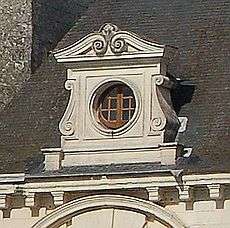Oeil-de-boeuf

An oeil-de-boeuf window of the Château de Chenonceau, France
An ""œil de bœuf" window in Lyon (France)
.jpg)
Oeil-de-boeuf, also œil de bœuf, (French, "bull's eye"), and sometimes anglicized as ox-eye window, is a relatively small oval window, typically for an upper storey, and sometimes set on a roof slope as a dormer, or above a door to give light. Windows of this type are commonly found in the grand architecture of Baroque France. The term is also so often applied to similar round windows, like those found in Georgian architecture in Great Britain, and later Greek Revival and Colonial Revival styles in North America, that this must be considered part of the usage. The term initially applied to horizontal oval windows, but is also used for vertical ones.[2]
See also
| Wikimedia Commons has media related to Oeil-de-boeuf. |
References
- ↑ Sutton Lodge Day Centre website
- ↑ Burden, Ernest E., Illustrated dictionary of architecture, McGraw-Hill Professional, 2001, p.354, ISBN 0-07-137529-5, ISBN 978-0-07-137529-0 Google books
This article is issued from
Wikipedia.
The text is licensed under Creative Commons - Attribution - Sharealike.
Additional terms may apply for the media files.